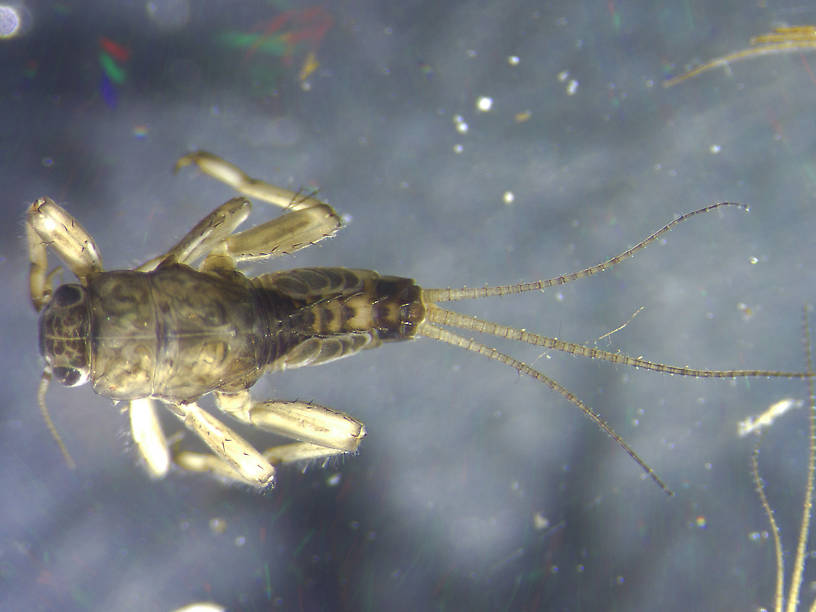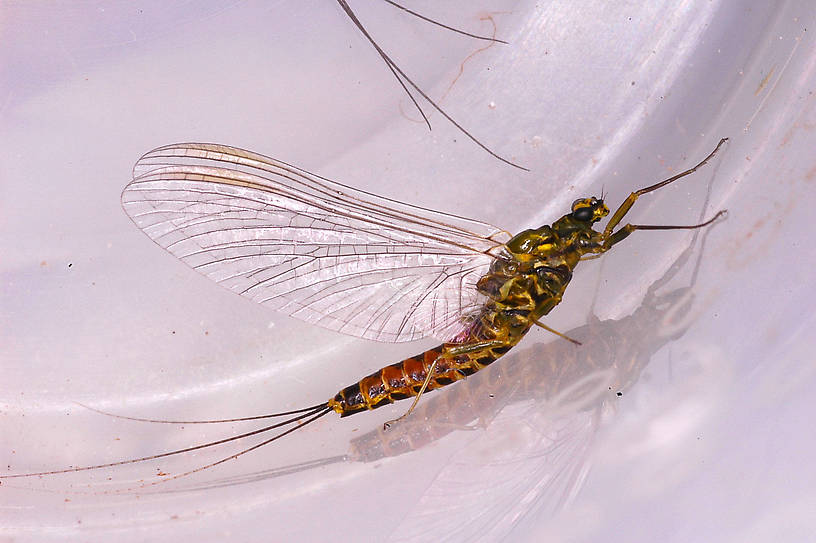
Salmonflies
Pteronarcys californica
The giant Salmonflies of the Western mountains are legendary for their proclivity to elicit consistent dry-fly action and ferocious strikes.


Mayfly Species Caudatella hystrix
Where & when
Time of year : July and August
In 2 records from GBIF, adults of this species have been collected during June (50%) and December (50%).
Species Range
Nymph biology
Current speed: Fast
Identification
To determine whether a specimen of Caudatella belongs to Caudatella hystrix, use the Key to Species of Caudatella Nymphs.
Physical description
Most physical descriptions on Troutnut are direct or slightly edited quotes from the original scientific sources describing or updating the species, although there may be errors in copying them to this website. Such descriptions aren't always definitive, because species often turn out to be more variable than the original describers observed. In some cases, only a single specimen was described! However, they are useful starting points.
Male Spinner
Wing length: 11–12 mm
Eyes reddish brown. Thorax dark reddish brown, lateral sutures and base of forewings light yellowish brown with a black lateral line which runs from the base of the forewing to the coxae of the forelegs; prosternum dark brown, nearly black, light vellowish brown near bases of legs; mesosternum dark brown medially, becoming lighter laterally; anterior half of metasternum dark brown, nearly black, posterior half yellow-brown, tibiae and distal end of femora of prothoracic legs dark brown; wings hyaline, longitudinal veins brown, crossveins pale. Abdominal terga black; segments 1 and 2 uniformly black; segments 3-9 with light oblique yellowish streaks that originate near the anterolateral corner of the tergum and extend beyond the middle, streaks broader and more pronounced on posterior segments; terga 3-8 with yellow lateral border and yellow maculae at posterolateral corners; terga 8 and 9 yellow along posterior margins; tergum 10 with yellow lateral and posterior margins; sterna 1-9 each marked with a broad dark reddish brown chevron as in fig. 8; sternum 10 dark brown, the chevron partially or entirely obscured. Caudal filaments brown, lateral cerci 65%-75% as long as terminal filament. Penes with two submedian apical lobes forming a deep median depression as in fig. 2.
Female Spinner
Wing length: 11–12 mm
Nymph
Mature Nymph—Length: body 9-11; cerci 6-8; terminal filament 9-11 mm. Head brown with pale markings; without occipital tubercles (fig. 17); antennae brown; maxillary palpi three-segmented. Pronotum and mesonotum brown with pale markings; legs brown, with scattered spines and hairs only, as in fig. 16; tarsal claws with 6-10 denticles. Abdominal terga brown with darker brown markings; terga 1-9 with median dark brown triangles; terga 2, 3, and 8 with dark lateral oblique dashes; tergum 9 dark brown, partially obscuring median and lateral markings: tergum 10 entirely dark brown; paired dorsal submedian tubercles on segments 2-9; tubercles short with bases close together on tergum 2, tubercles longer and bases more widely separated to tergum 7; tubercles on terga 2-7 uniformly divergent; tubercles on terga 8 and 9 are less divergent, shorter and more narrowly separated than those on tergum 7 (fig. 26); sterna light brown, each with a dark brown chevron (fig. 8); sternum 9 may be dark brown, partially obscuring chevron. Caudal filaments brown, darker at joinings, lateral cerci 65% to 75% as long as terminal filament.
Nymph
Cerci 4-5 mm; terminal filament 6-7 mm. Head brown with pale markings; moderately developed paired submedian occipital tubercles (fig. 18); antennae light brown: maxillary palpi three-segmented. Pronotum brown, with low, rounded, paired submedian thoracic tubercles and paired, sublateral smaller tubercles near the hind margin; mesonotum brown, roughened, but without tubercles. Legs brown with scattered spines and hairs only, similar to those in fig. 16; tarsal claws with 7-10 denticles. Abdominal terga light brown with variable lateral darker markings; tergum 10 light brown; long, thin, paired dorsal submedian tubercles on segments 2-9 (fig. 25) ; base of tubercles on segment 2 close together, becoming more widely separated to segments 6 to 8, and closer together on segment 9; all tubercles divergent apically; tubercles on terga 2 to 4 arise at a nearly perpendicular angle with their tips directed posterolaterally; tubercles on terga 5-8 directed more laterally and less perpendicularly than any of the preceding tubercles; tubercles on tergum 9 nearly straight and directed posterolaterally; sterna dark brown with light brown lateral margins similar to those in fig. 9. Caudal filaments brown, lateral cerci 65% to 75% as long as terminal filament.
Specimens of the Mayfly Species Caudatella hystrix
1 Male Spinner
1 Nymph

Start a Discussion of Caudatella hystrix
References
- Merritt R.W., Cummins, K.W., and Berg, M.B. 2019. An Introduction to the Aquatic Insects of North America (Fifth Edition). Kendall/Hunt Publishing Company.
Mayfly Species Caudatella hystrix
Species Range
Resources
- NatureServe
- Integrated Taxonomic Information System
- Global Biodiversity Information Facility
- Described by Traver (1934)


